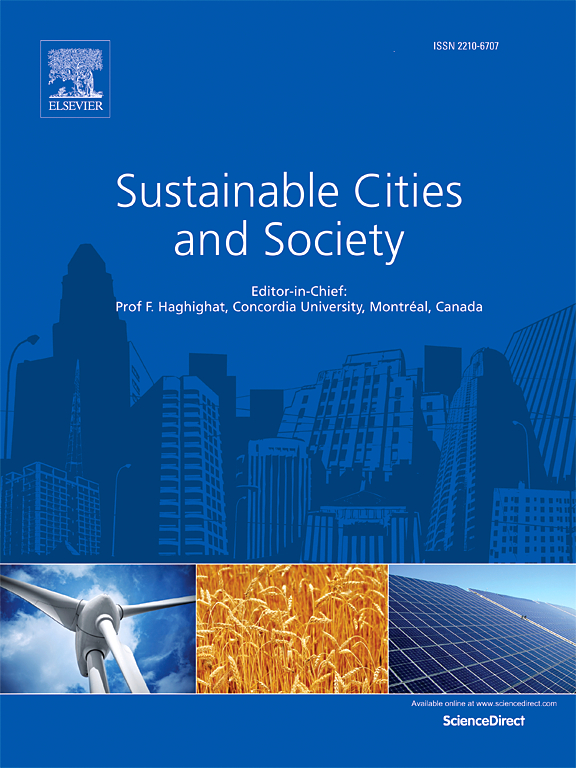Impact of spatial configuration of urban blue spaces in mitigating temperature during summer: a remote sensing and field-based observation
IF 10.5
1区 工程技术
Q1 CONSTRUCTION & BUILDING TECHNOLOGY
引用次数: 0
Abstract
Cities worldwide face heightened vulnerability to extreme heat due to rapid urbanization and the conversion of natural spaces into built-up areas. This challenge is particularly severe in the global south, where rapid urban expansion leads to the loss of green and blue spaces, essential for temperature mitigation. This study investigates how the spatial configuration of urban blue spaces affects summer temperatures, using remote sensing and field data from a rapidly growing urban agglomeration i.e., English Bazar Urban Agglomeration (EBUA) in Eastern India. The study applied ANOVA and Tukey’s HSD tests to assess temperature differences across urban core, transitional, and rural zones, comparing remote sensing and field data. Bayesian regression analyses further explore relationships between temperature and various explanatory factors, including vegetation and built-up density. Results indicate elevated land surface temperature (LST) in the urban core, reaching a peak of 63.08 °C at 80 m from blue spaces. In the transitional zone, LST shows moderate increases, from 62.21 °C at the blue space edge to 63.06 °C at 100 m. In rural areas, LST starts lower at 60.83 °C, showing minimal variation due to cooling effect of vegetation cover. ANOVA results reveal no significant variation across zones of temperature in remote sensing data (p = 0.144), possibly due to spatial averaging, while field data shows significant differences (p = 0.00045), capturing localized temperature changes. Bayesian regression highlights percentage of vegetation cover, normalized difference water index (NDWI), normalized difference built-up index (NDBI), and area of blue space as key LST predictors, with an R² of 0.875. The findings of the study on the investigation the impact of the spatial configuration of blue spaces on temperature mitigation is crucial in order to facilitate sustainable urban planning. Blue spaces that are well-designed have the potential to increase thermal comfort, enhance microclimate regulation, and reduce urban heat island (UHI) effect. This research can contribute to the development of climate-resilient strategies that promote energy-efficient urban development, public health, and biodiversity.
城市蓝色空间形态对夏季降温的影响:遥感与野外观测
由于快速城市化和自然空间向建成区的转变,世界各地的城市对极端高温的脆弱性日益增强。这一挑战在全球南方国家尤为严峻,在那里,城市的迅速扩张导致了对减缓温度至关重要的绿色和蓝色空间的丧失。本文利用印度东部快速发展的英吉利巴扎尔城市群(EBUA)的遥感和野外数据,研究了城市蓝色空间的空间结构对夏季气温的影响。该研究采用方差分析和Tukey的HSD测试来评估城市核心、过渡和农村地区的温度差异,并比较了遥感和实地数据。贝叶斯回归分析进一步探讨了温度与各种解释因子的关系,包括植被和建筑密度。结果表明,城市核心区域地表温度升高,在距离蓝色空间80 m处达到63.08℃的峰值。在过渡带,地表温度从蓝色空间边缘的62.21°C上升到100 m高度的63.06°C。在农村地区,地表温度开始较低,为60.83°C,由于植被覆盖的降温作用,地表温度变化最小。方差分析结果显示,遥感数据的温度在不同区域之间没有显著差异(p = 0.144),这可能是由于空间平均造成的,而现场数据显示出显著差异(p = 0.00045),捕获了局部温度变化。贝叶斯回归强调植被覆盖度百分比、归一化差水指数(NDWI)、归一化差建筑指数(NDBI)和蓝色空间面积是地表温度的关键预测因子,R²为0.875。关于蓝色空间的空间结构对温度缓解的影响的调查研究结果对于促进可持续的城市规划至关重要。精心设计的蓝色空间具有增加热舒适、加强小气候调节和减少城市热岛效应的潜力。这项研究有助于制定气候适应战略,促进节能城市发展、公共卫生和生物多样性。
本文章由计算机程序翻译,如有差异,请以英文原文为准。
求助全文
约1分钟内获得全文
求助全文
来源期刊

Sustainable Cities and Society
Social Sciences-Geography, Planning and Development
CiteScore
22.00
自引率
13.70%
发文量
810
审稿时长
27 days
期刊介绍:
Sustainable Cities and Society (SCS) is an international journal that focuses on fundamental and applied research to promote environmentally sustainable and socially resilient cities. The journal welcomes cross-cutting, multi-disciplinary research in various areas, including:
1. Smart cities and resilient environments;
2. Alternative/clean energy sources, energy distribution, distributed energy generation, and energy demand reduction/management;
3. Monitoring and improving air quality in built environment and cities (e.g., healthy built environment and air quality management);
4. Energy efficient, low/zero carbon, and green buildings/communities;
5. Climate change mitigation and adaptation in urban environments;
6. Green infrastructure and BMPs;
7. Environmental Footprint accounting and management;
8. Urban agriculture and forestry;
9. ICT, smart grid and intelligent infrastructure;
10. Urban design/planning, regulations, legislation, certification, economics, and policy;
11. Social aspects, impacts and resiliency of cities;
12. Behavior monitoring, analysis and change within urban communities;
13. Health monitoring and improvement;
14. Nexus issues related to sustainable cities and societies;
15. Smart city governance;
16. Decision Support Systems for trade-off and uncertainty analysis for improved management of cities and society;
17. Big data, machine learning, and artificial intelligence applications and case studies;
18. Critical infrastructure protection, including security, privacy, forensics, and reliability issues of cyber-physical systems.
19. Water footprint reduction and urban water distribution, harvesting, treatment, reuse and management;
20. Waste reduction and recycling;
21. Wastewater collection, treatment and recycling;
22. Smart, clean and healthy transportation systems and infrastructure;
 求助内容:
求助内容: 应助结果提醒方式:
应助结果提醒方式:


